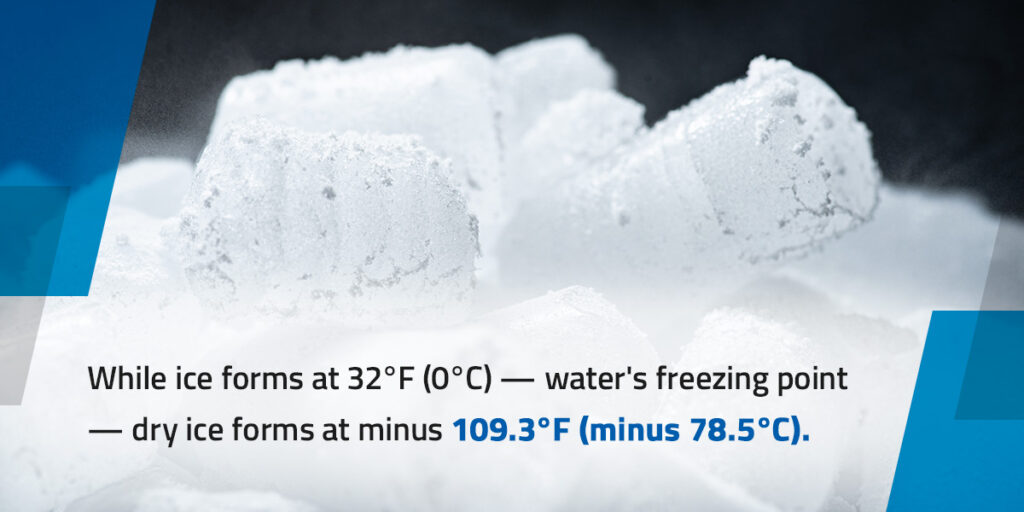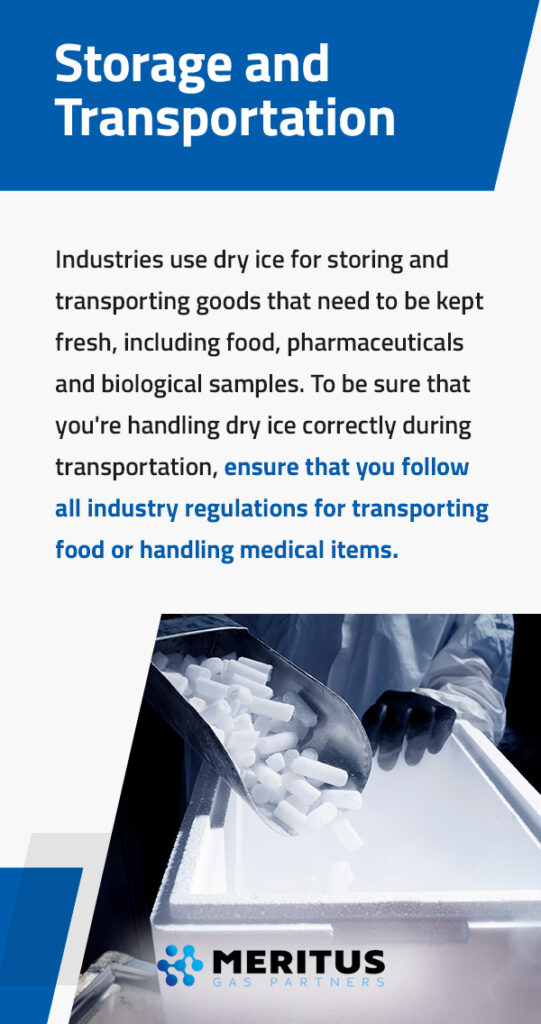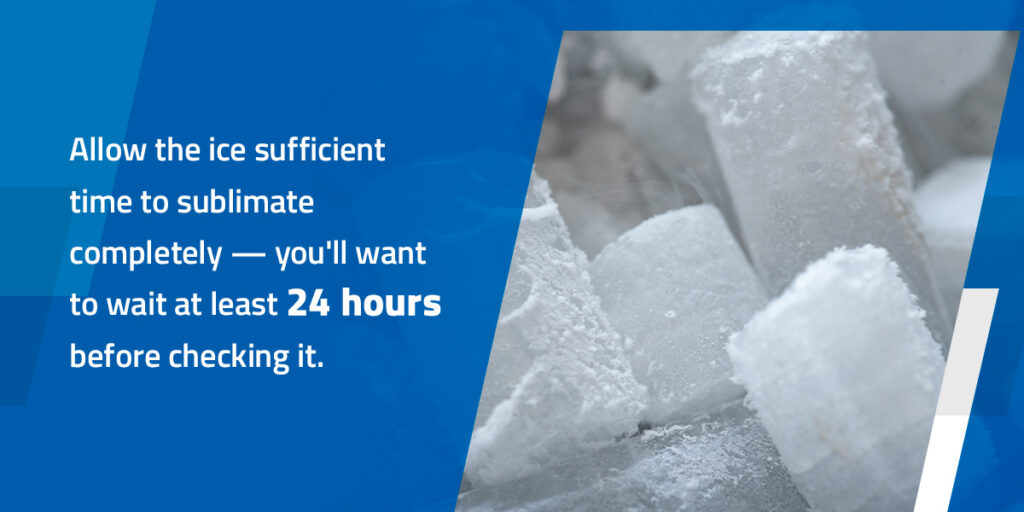

Dry ice is very different from the ice we get when water freezes. As solidified carbon dioxide, dry ice has the same chemical formula as carbon dioxide gas — CO2 — just in a different form. Because dry ice is extremely cold, it has many practical uses.
Medical professionals sometimes use dry ice as an alternative to liquid nitrogen. Doctors can use the substance in minor surgeries to remove skin imperfections and to store various biological samples to keep them fresh. Dry ice is an essential tool in the food industry, seeing use by restaurants, supermarkets and commercial kitchens to meet food storage and preparation regulations. In shipping, dry ice keeps perishables cold and fresh until they reach their destination.
While dry ice clearly is valuable for many different applications, anyone handling it must do so with care. Working with dry ice without following safety precautions or proper storage guidelines can lead to severe injuries.
This comprehensive guide will cover how to handle dry ice, including the proper ways to store, transport, ventilate and dispose of it.

Dry ice is produced by cooling and pressurizing carbon dioxide gas to get it to solidify. Carbon dioxide gas solidifies at extremely low temperatures. While ice forms at 32°F (0°C) — water’s freezing point — dry ice forms at minus 109.3°F (minus 78.5°C).
Other key properties and characteristics of dry ice include:
CO2’s unique properties make dry ice an ideal substance for a range of different use cases beyond those mentioned here:
Due to some of its extreme properties — like its very low temperature — there are hazards associated with using dry ice:
The Compressed Gas Association (CGA) works directly with regional, state and federal agencies to promote gas-related safety practices and regulations. The CGA also outlines specific guidelines for handling CO2 according to health and safety standards. Implementing adequate safety measures when handling dry ice is essential to avoiding injury. Observe the following guidelines for dry ice storage, disposal and transport to protect yourself and anyone else in the vicinity.

Industries use dry ice for storing and transporting goods that need to be kept fresh, including food, pharmaceuticals and biological samples. By law, dry ice is a hazardous material, and anyone handling it must have the correct training to do so. All shipping companies have specific guidelines for transporting hazardous materials. Additionally, the United States Department of Transportation (DOT) has the following Materials of Trade (MOT) regulations in place:
Another important safety tip for moving dry ice is not to set the ice directly into empty glass containers or on surfaces like countertops. The extreme difference in temperature can crack the surface or container.
It’s imperative to avoid direct skin contact when working with dry ice, as it can cause frostbite very quickly. Although a very brief touch may not necessarily cause harm, no amount of contact is considered safe. Touching dry ice, even for just a second, may make skin red and sensitive, just like a hot burn.
If you maintain contact with dry ice for longer than a second or two, your skin cells will start to freeze and die. Holding on to dry ice without protective gear will cause varying degrees of frostbite. Frostnip, a milder form, is what happens when the skin turns red or purple from brief exposure to extreme cold. Even though frostnip is temporary, it’s best to treat it immediately and see a health care professional to avoid any chance of lasting problems.
Superficial or surface frostbite requires prompt medical attention. Signs of superficial frostbite include skin feeling warm, pins and needles in the affected area, blue and purple patches that resemble bruising, stinging and swelling, peeling, and blisters.
The third stage of frostbite is deep, severe damage that affects subcutaneous tissue — the lower, deeper layers of skin. Severe frostbite makes skin completely numb and may make it impossible to move the affected area. Blisters will form and skin will become hard and black. This extensive tissue damage can cause additional complications due to lack of blood supply to the affected tissue, including secondary infections and gangrene. Severe frostbite is a medical emergency requiring urgent care.
The danger in handling dry ice for even brief periods is that the numbness caused by the cold may prevent you from realizing that frostbite is setting in. Always follow these safety precautions to prevent the chance of dry ice burn:
When you expose dry ice to room temperature, it sublimates, changing straight from a solid to a gas. Due to the potential dangers of sublimation, you need to take careful measures to ensure your dry ice storage area is suitable for the task. Never store dry ice in an airtight container, as the resulting buildup of gas will likely cause an explosion. Similarly, do not dispose of dry ice by throwing it in a sink, toilet or drain of any kind, as the pipes may freeze or burst.
There is also the risk of asphyxiation as dry ice sublimates and displaces oxygen in the air. Exposure to large volumes of CO2 gas lowers the amount of oxygen in the body, which causes hypoxia. Symptoms of hypoxia include difficulty breathing, rapid heartbeat, restlessness, confusion and bluish skin.
To prevent explosions or asphyxiation, label all containers to show they contain dry ice, ensure that they are not airtight and store them in a space with ample ventilation. Do not store dry ice in confined areas like walk-in refrigerators. Only use packaging that has been designed specifically for holding dry ice, like a specially made cooler or insulated container. You can use Styrofoam coolers, as they are insulated but not airtight.
If you are storing large quantities of dry ice, consider monitoring oxygen levels in the area as an added safety measure.

Having a safe dry ice disposal method is just as important as using safe handling practices. Dry ice will sublimate when you discard it, so you want to have a proper space for it to do so safely, such as an inaccessible outdoor area. You can take these steps to keep everyone in the vicinity safe:
You can obtain dry ice from industrial gas suppliers, companies that supply welding industries and relevant regional suppliers. Some grocery stores may also carry dry ice. Depending on the supplier, orders can be collected directly or delivered regionally. If shipped, the dry ice will be transported in insulated packaging and in accordance with MOT regulations.
Find a Meritus Gas Partner Near YouThe size of the block of dry ice you get and how you store it are some of the factors affecting how long it lasts. If you leave a small- to medium-sized block of dry ice out at room temperature, it will likely sublimate within three to five hours. However, you can keep your dry ice for longer by storing it in an insulated cooler (with sufficient venting). If you store two blocks of dry ice in a regular-sized Styrofoam cooler, it can last for around 24 hours. A large quantity of dry ice properly stored in a sizeable, thick Styrofoam cooler may last three to four days.
Some common mistakes when handling dry ice include not wearing appropriate PPE, storing it in a freezer or in a tightly sealed container, ordering more dry ice than what you need and disposing of it incorrectly. Another common error is purchasing the ice too far in advance, which results in it starting to sublimate before it can be used. For that reason, you should always aim to receive or collect a dry ice order only a few hours before you need it.

Following the proper procedures and recommendations for handling dry ice is a good business practice. By training staff, supplying PPE and emphasizing the significance of safe practices for using this substance, you can mitigate risks and protect your staff. You can also contact your local gas supplier to discuss your needs regarding dry ice. A knowledgeable supplier will be able to fill your order as well as provide the guidance you need to transport and handle it.
At Meritus Gas Partners, our partners are reputable distributors in the industry that you can trust for your gas needs and welding supplies. Our partner businesses offer premium gas and welding solutions that empower you to improve your operations.
You can visit any of our affiliated branches or contact us today with any questions for our expert team. We’ll connect you with efficient and helpful services, supplies and equipment from a partner near you.